5 Steps to running an optimized event-specific marketing campaign
An event-specific marketing campaign is a form of newsjacking where you leverage the awareness of a current event to showcase the value and benefits of your product or service.
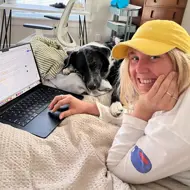
Shannon Byrne
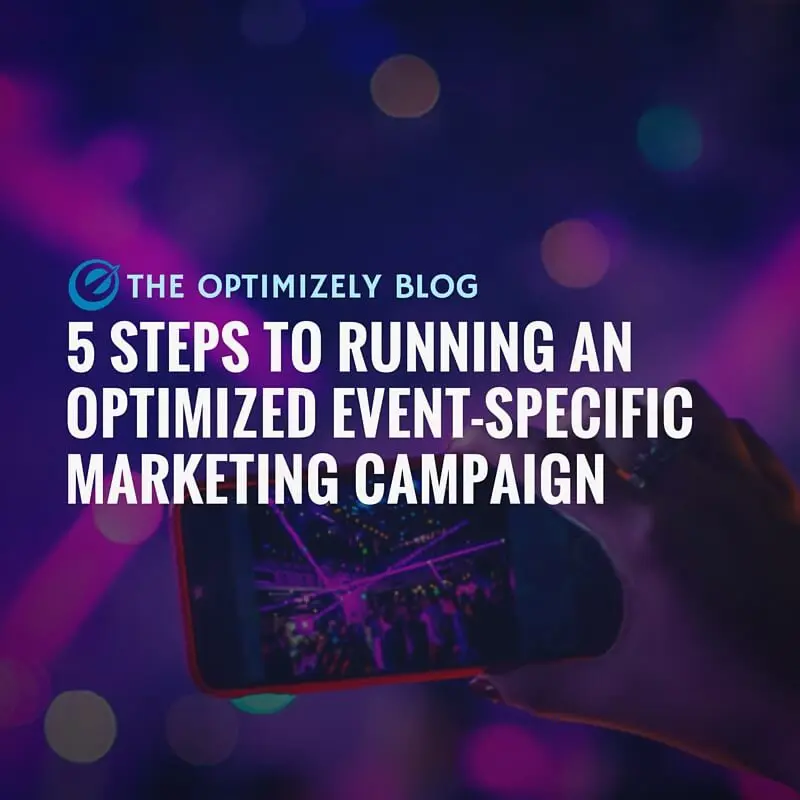
The objective is to drive brand awareness and traffic among a larger audience than you’d normally reach. There are two types of events you can build off of:
1) Time-sensitive events: One-time, typically unexpected events. Sometimes they’re announced in advance, giving you time to plan (i.e. a royal wedding or the release of a new Star Wars film). Other times, they’re sudden occurrences, such as a large tech company shutting down or the surprise launch of a new Apple product.
2) Planned events: Large, recurring events that happen periodically at the same time each period. Examples include the Super Bowl, Olympics, Presidential Election, World Cup, and holidays real and fake such as Christmas, Black Friday, etc.
Running campaigns specific to time-sensitive or planned events are an effective product marketing and growth hacking tactic for two reasons. They’re an opportunity to drive high volumes of targeted traffic and they provide an ideal setting to run a/b tests on offers, messaging, images, colors, onboarding, and more.
But before you can run a campaign or test it, you need to choose an event!
Choosing an event for your campaign
When choosing what event to base your campaign on, consider your buyer personas. These are general profiles of your customers that should include key information about who they are — from the problems they need to solve to the types of blogs they read or podcasts they listen to. Think about events that would relate to their interests — tech, food, sports, music, film, etc. Also think about how their interests relate to big, nationwide or worldwide events like a political election or the Olympics that generate buzz among all demo- and psychographics.
Pick only the events that allow you to showcase the value of your product or service. For us at Geckoboard (a TV dashboard application for monitoring your key metrics), this means any event where data plays a critical role: game stats, election stats, social mentions, etc.
Once you’ve identified your target events, follow these five steps for running a fully-optimized event-specific campaign to drive more traffic and conversions!
Step One: Conduct Keyword Research Around Your Event
Now that you have a short list of events, conduct keyword research to determine what related terms your audience is searching for around the event. The more relevant keywords you use in your campaign, the more people you’ll reach and the more traffic you’ll drive.
Let’s say you’re building a campaign around the 2016 U.S. Presidential Election (such as freestdccheck.org’s billboard campaign, “Feel the Burn?” around Bernie Sanders’ slogan). Use a tool like Moz’s Keyword Difficulty Tool or a free one like Google Trends to determine which other terms people interested in the event are searching for. If you search Google Trends for search volume around “Presidential Election” from Jan. 2014 – March 2016, these are the related search terms people are using:
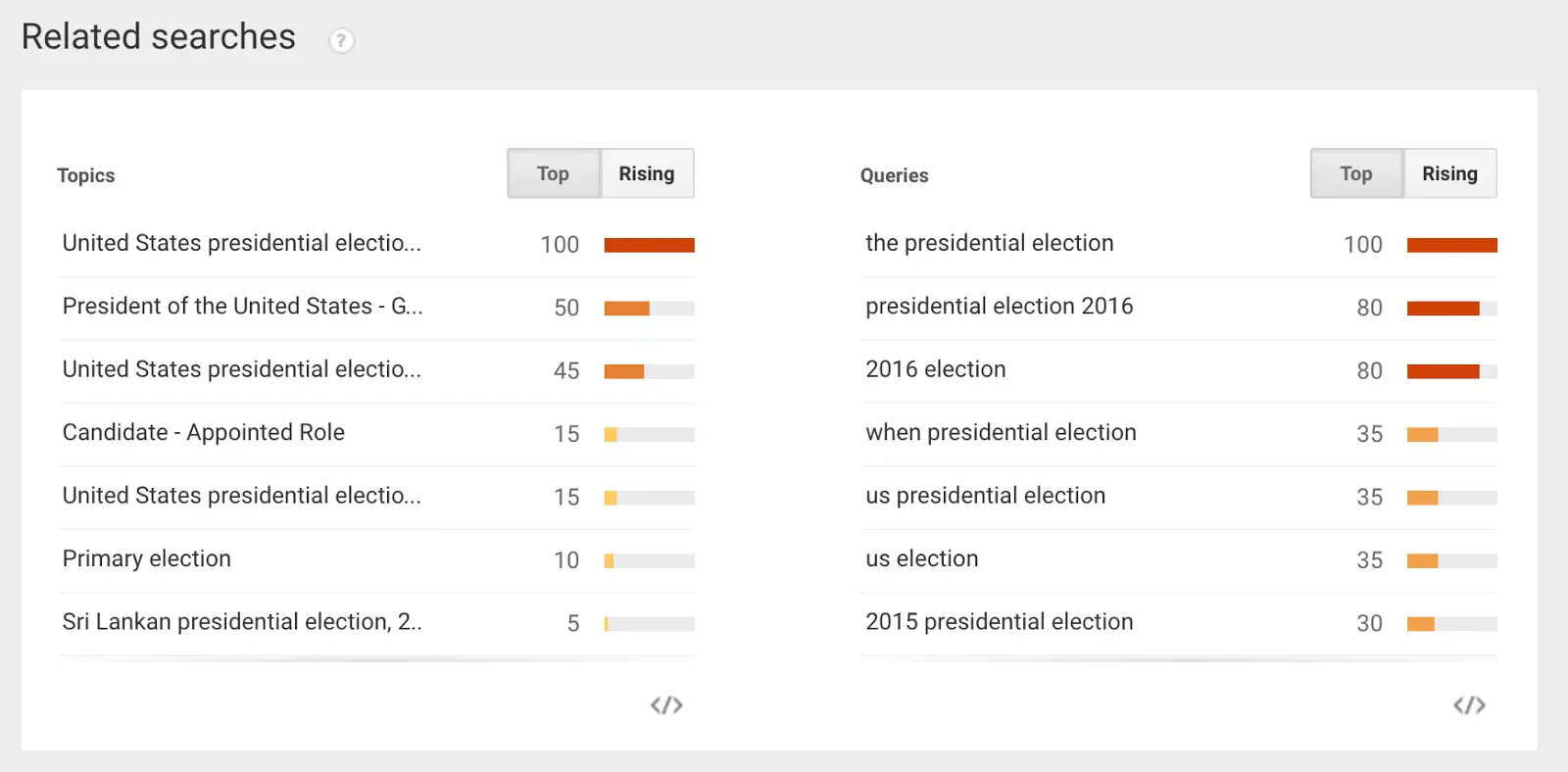
With this information, you know to use terms like “the presidential election,” “presidential election 2016” and “2016 election” on your campaign’s landing page and in the content promoting it to capture more search traffic than you would using only the event name.
Step Two: Build an Optimized Landing Page
You need a landing page specific to your campaign and the event you’re targeting otherwise the visitors you’re driving with your targeted keywords identified in step one will bounce as soon as they land on your page. Worse, you could lose trust among these new visitors by not delivering on the promise of your headline or title. Your campaign should be relevant to the event you’re targeting and add value for people interested in it.
Your campaign and landing page should also be branded so as people use your product, they learn about your brand as a solution. Make sure to have a clear call to action to try your product on your landing page. Here’s an example of the one we built for our 2016 U.S. Presidential Campaign:
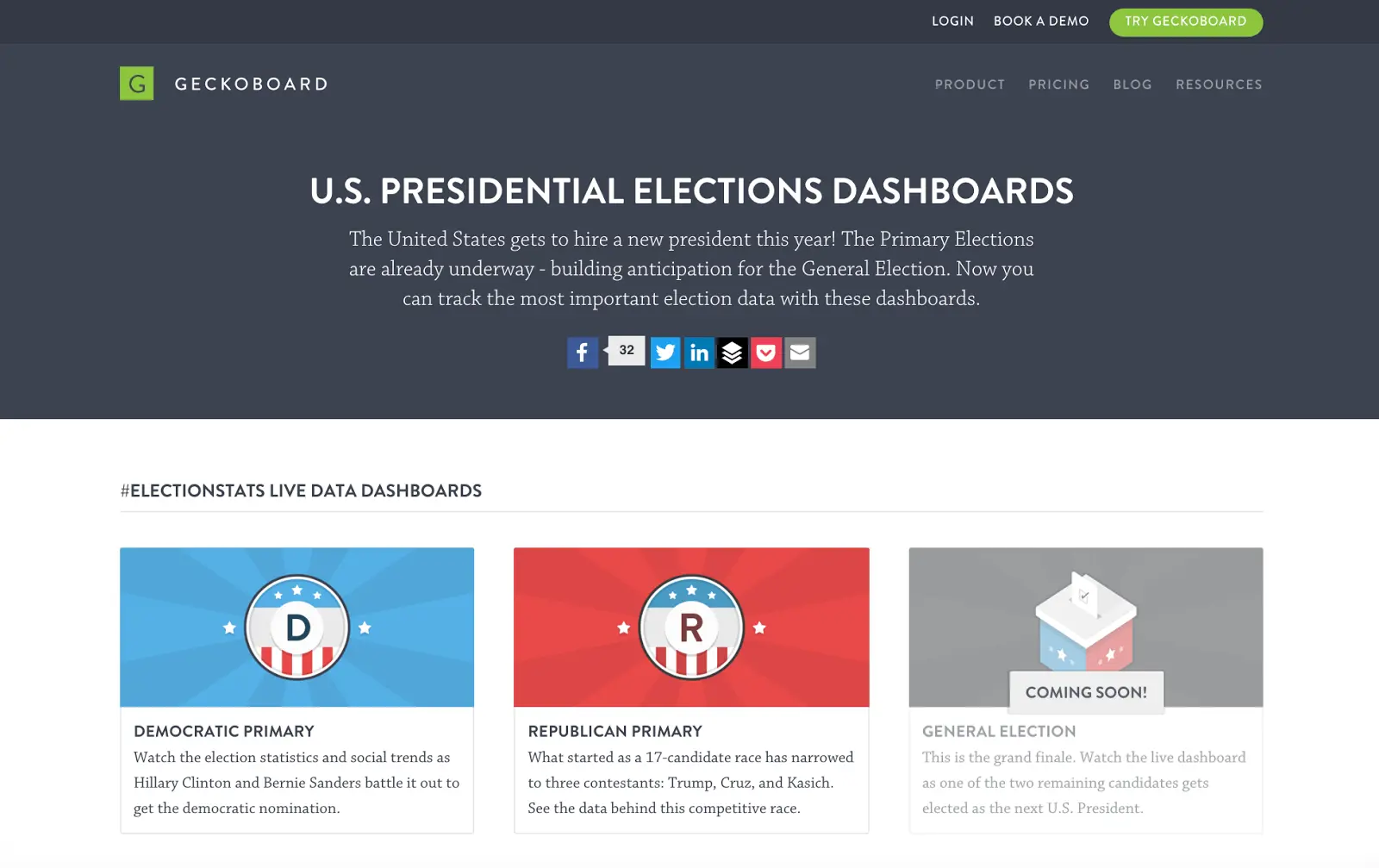
We put the Presidential Dashboards front and center, but kept our normal navigation so new visitors could explore the site.
The look and feel of your page matters too. These characteristics will increase the likelihood of someone staying on and even sharing your campaign:
- Focused: As soon as someone lands on your page, they should know what they’re looking at and why. Keep the language tight and focused on the solution you’re offering and how it relates to your target event.
- Sharable: Include easy social-share buttons so visitors can share your campaign with one click.
- Simple: Use only a few, attractive colors, high-res graphics or images, proper spacing and page flow to keep your visitors.
Your landing page is your opportunity to a/b test what landing page elements convert the most customers for your product, which leads to the next step.
Step Three: Set Up A/B Testing for Your Campaign
When a/b testing an event-specific landing page in Optimizely, you’ll first want to run a “monitoring campaign” to determine your baseline conversion rate – the control in your test that you’ll measure against. A monitoring campaign has only an original version, no variations – it’s sole purpose is to measure baseline conversions.
After establishing your baseline conversions, determine how long you should run your a/b test for. Your optimized sample size (i.e. how many visits until you end a test) will depend on your company and campaign goals. Optimizely has a handy and thorough calculator that will help you determine this.
The next step is to choose which element to a/b test. Many argue that the most important element to test is the offer. That is, your call to action. Are you offering a 14-day free trial? Exclusive access to a feature? A bonus month?
One option is to test an offer or two different offers to see which converts the best — which drives the most trial signups and which leads to more paying customers. However, your trials will have to run their course before you can determine paying conversions.
Electronic Arts, Inc. tested a $20 off offer with pre-order during the launch of SimCity but found that the page without the offer drove 43.4% more purchases.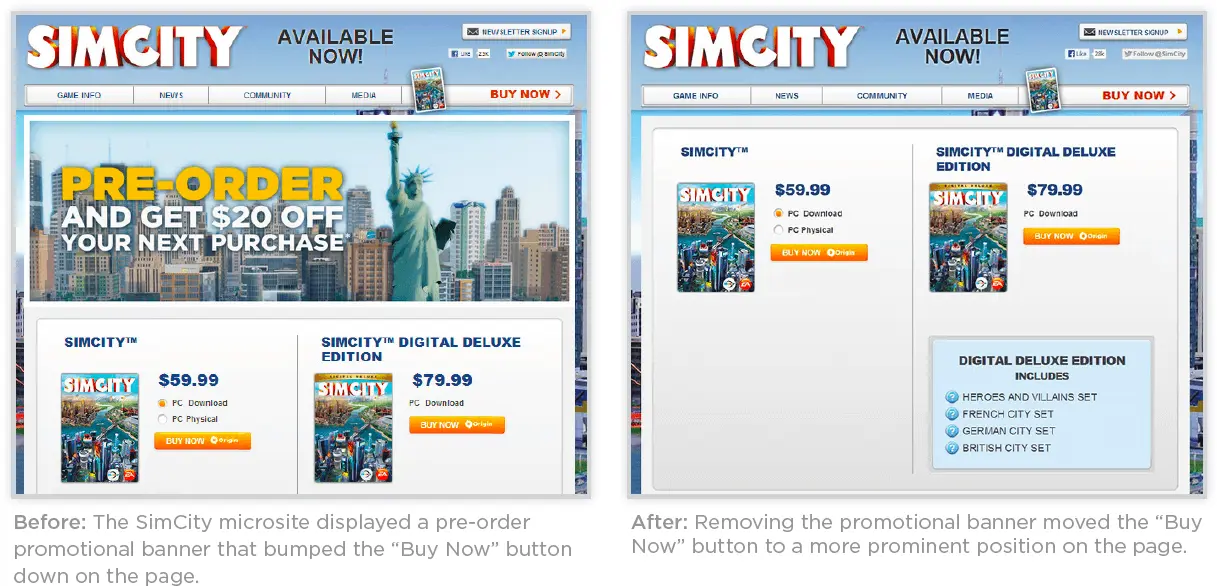
Another option is to keep only one offer and test the copy you use for it. You can express urgency with words like “limited time offer” or “one-time chance.” Or you can highlight the value of the offer by indicating how much they’re saving by signing up now. Test different messaging to determine which drives the most clicks.
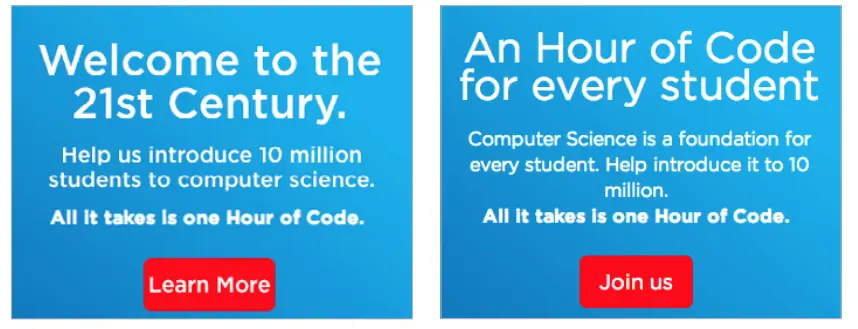
Code.org tested a more community focused CTA with “Join us,” which resulted in an increase of 29% in signups for their Hour of Code course.
Other elements to consider testing include: your onboarding process, the color of your CTA buttons, where your offer is placed, the headline of your page, or different images.
Step Four: Promote Your Campaign
Proper planning is crucial when running a timely campaign. As you execute steps one through three, have someone planning the promotion of your campaign. Some examples of how you can promote an event-specific campaign effectively include:
Publication and blogger outreach: Reach out to relevant media sites with an interesting and unique angle about how your campaign adds value to the event. Keep communication highly targeted to relevant writers covering that specific beat or writing for your target audience. Make sure they link to your landing page!
Social media (organic): Identify any major hashtags people are using to talk about the event in advance. Work those into your tweets to increase the likeliness of a broad audience or anyone monitoring the event seeing it. Use unique and compelling images to stand out among the rest. Consider using witty, shocking, or emotional language to pique interest and intrigue.
Paid social ads: Consider promoting your campaign using promoted posts on social media. Keep your images, copy, and call to actions compelling and fresh. Have a few ready to rotate out, as paid ads on social go stale fast. The great thing about paid for event-specific campaigns is that you can target the specific interests and hashtags of the event.
Product Hunt: If you’re promoting a tech product, Product Hunt is a great community to share your campaign with and solicit feedback. Other potentially relevant forums to check out include Reddit or Hacker News.
Adwords: Much like paid social, a Google Adwords campaign could be effective in reaching people who are searching for the event.
Content marketing: Write articles or create videos or podcasts related to your campaign. This gives you something to promote other than just your landing page. By linking to your landing page, you’ll also help improve your landing page’s search ranking (as long as the content is high-quality, of course). Leverage content intelligence to gain insight into your content performance.
Experiential marketing: Use experiential marketing campaigns for important campaigns, and create personalized experiences for your customers and prospects.
Influencer marketing: Incorporating insights, opinions, or content from someone of influence will help boost the organic virality of your campaign. That is, if they’re relevant to the event you’re targeting, have a recognizable name, and are willing to share it with their networks.
Step Five: Analyze the Results
No campaign is complete without measuring its success. Once the event is over and the buzz has worn off, look at all metrics including traffic, conversions, social shares and beyond. Distill your data down to:
- Top referrers
- Who signed up
- Where they came from
- What your search ranking was
- What the bounce rate was for various referrers, copy used, and call to actions
Also compare different promotional tactics to determine which was more effective.
All of these results will help you determine if event-specific campaigns are worth it for your company, as well as what works and what doesn’t. Take these learnings and apply them to your next campaign. Cut what doesn’t and put more time and effort into what does.
